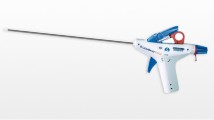Abstract
Introduction
Laparoscopic repair of inguinal hernias is usually achieved by totally extraperitoneal (TEP) or transabdominal preperitoneal (TAPP) techniques. The intraperitoneal onlay mesh (IPOM) could be an interesting alternative as it is much easier to perform and faster to execute. This technique is subject to correct selection of indications and to demonstration of its safety.
Materials and methods
From January 2003 to January 2006 we performed 61 laparoscopic hernia procedures on 60 selected patients (60 males with a mean age of 60 and mean weight of 76 kg) with an IPOM technique combining the Parietex composite mesh (12 cm circular model) and a fibrin glue (Tissucol) for its fixation. The glue was diluted to increase fixation time and applied to the mesh prior to positioning on the hernia defect.
Results
Mean operative time was 10 minutes. Mean hernia diameter was 2.5 cm (± 0.8 cm). 10 hernias were direct, 51 were indirect and 10 out of 61 were recurrent. We did not convert any of the laparoscopic procedures. Mean hospital stay was one day; mean recovery time for working and general physical activities was five days. Patients were checked after one week, 1-3-6 months and 1-2 years. Average follow up time was 23.7 months. 1.6 % of patients showed short-term complications: one trocar site haematoma. No additional complications were reported; particularly, we had no recurrence, no seroma, no mesh migration, and no bowel obstruction or fistula.
Conclusion
Results of this study show intraperitoneal (IP) tolerance to this kind of mesh and the safety of its fixation with Tissucol. The absence of recurrence and complications could be a good reason to extend the indication of IPOM hernia repair. However, these preliminary results should be confirmed by longer follow-up.




Similar content being viewed by others
References
Blanc P, Porcheron J, Breton C, Bonnot P, Baccot S, Tiffet O, Cuilleret J, Balique JG (1999) “Resultats des hernioplasties coelioscopiques. Etude de 401 cas chez 318 patients”. Chirurgie 124: 412–8
Catani M, Milito R, Pietroletti R, Chiaretti M, Spaziani E, Leardi S, Simi M (2004) “Is there a place for intraperitoneal onlay mesh repair (IPOM) of inguinal hernia among laparoscopic techniques?” Hepatogastroent 51: 1387–92
Fitzgibbons R, Camps J, Cornet D, Nguyen NX, Litke BS, Annibali R, Salerno GM (1995) “Laparoscopic inguinal herniorraphy: results of a multicenter trial”. Ann Surg 221: 313–8
Gillion JF, Elhadad A, Balique JG, Begin GF, Fourtanier G (1996) “Two-year results of celioscopic hernioplasties using an intraperitoneal ePTFE patch. A prospective multicenter study of 184 cases. Groupe CHIC (Cure des hernies inguinocrurales sous coelioscopie)”. Ann Chir 50(9):799–802
Hatzitheofilou C, Lakhoo M, Sofianos C, Levy R, Velmahos G, Saadia R (1997) “Laparoscopic inguinal hernia repair by an intraperitoneal onlay mesh technique using expanded PTFE : a prospective study”. Surg laparosc Endosc 7: 451–455
Kapiris SA, Brought WA, Royston CMS, O’Boyle C, Sedman PC (2001) “Laparoscopic transabdominal preperitoneal (TAPP) hernia repair”. Surg Endosc 15: 972–5
Kaufman Z, Engelberg M, Zager M. (1981) “Fecal fistula: a late complication of Marlex mesh repair”. Dis Colon Rectum 24:543–4
Kingsley D, Vogt DM, Nelson MT, Curet MJ, Pitcher DE (1998) “Laparoscopic intraperitoneal onlay inguinal herniorrhaphy”. Am J Surg 176: 548–53
Memon MA, Feliu X, Sallent EF, Camps J, Fitzgibbons RJ Jr (1999) “Laparoscopic repair of recurrent hernias”. Surg Endosc 13: 807–10
Ramshaw B, Shuler FW, Jones HB, Duncan TD, White J, Wilson R, Lucas GW, Mason EM (2001) “Laparoscopic hernia repair: lesson learned after 1224 consecutives cases”. Surg Endosc 15: 50–4
Sarli L, Pietra N, Choua O, Costi R, Cattaneo G (1997) “Laparoscopic hernia repair. A prospective comparison of TAPP and IPOM techniques”. Surg Lapar & Endoscopi 6: 472 – 476
Schmidt J, Carbajo MA, Lambert R, Zirngibl H (2001) “Laparoscopic intraperitoneal onlay polytetrafluoroethylene mesh repair (IPOM) for inguinal hernia during spinal anestesia in patients with severe medical conditions”. Surg Lap Endosc & Percut technique 1: 34–37
Spaw AT, Ennis BW, Spaw LP (1991) “Laparoscopic hernia repair: the anatomic basis”. J Laparosc Surg 1: 269–73
Stoppa RE, Rives JL, et al. (1984) “The use of Dacron in the repair of hernias of the groin”. Surg Clin North Am 64: 269–285
Toy FK, Moskowitz M, Smoot RT, Pleatman M, Bagdasarian A, polito W, Carey SD, Schatz R, Janes K, Zipser ME (1996) “ Results of a prospective Multicenter trial evaluating the ePTFE peritoneal onlay laparoscopic inguinal hernioplasty”. J Laparoendosc Surg 6:375–386
Toy FK, Smoot RT Jr (1991) “Laparoscopic hernioplasty”. Surg Laparosc Endosc 1:151–5
Tsang S, Normand R, Karlin R (1994) “Small bowel obstruction: a morbid complications after laparoscopic herniorraphy”. Am Surg 6: 332–4
Wright D, Paterson C, Scott N, Hair A, O’Dwyer J (2002) “Five year follow up of patients undergoing laparoscopic or open hernia repair. A randomized controlled trial”. Ann Surg 3: 333–7
Author information
Authors and Affiliations
Corresponding author
Rights and permissions
About this article
Cite this article
Olmi, S., Scaini, A., Erba, L. et al. Laparoscopic repair of inguinal hernias using an intraperitoneal onlay mesh technique and a Parietex composite mesh fixed with fibrin glue (Tissucol). Personal technique and preliminary results. Surg Endosc 21, 1961–1964 (2007). https://doi.org/10.1007/s00464-007-9355-0
Received:
Revised:
Accepted:
Published:
Issue Date:
DOI: https://doi.org/10.1007/s00464-007-9355-0




